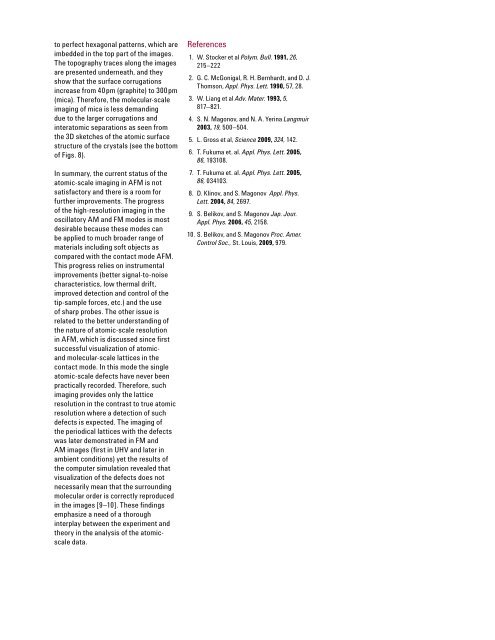Application Compendium - Agilent Technologies
Application Compendium - Agilent Technologies
Application Compendium - Agilent Technologies
You also want an ePaper? Increase the reach of your titles
YUMPU automatically turns print PDFs into web optimized ePapers that Google loves.
to perfect hexagonal patterns, which are<br />
imbedded in the top part of the images.<br />
The topography traces along the images<br />
are presented underneath, and they<br />
show that the surface corrugations<br />
increase from 40pm (graphite) to 300pm<br />
(mica). Therefore, the molecular-scale<br />
imaging of mica is less demanding<br />
due to the larger corrugations and<br />
interatomic separations as seen from<br />
the 3D sketches of the atomic surface<br />
structure of the crystals (see the bottom<br />
of Figs. 8).<br />
In summary, the current status of the<br />
atomic-scale imaging in AFM is not<br />
satisfactory and there is a room for<br />
further improvements. The progress<br />
of the high-resolution imaging in the<br />
oscillatory AM and FM modes is most<br />
desirable because these modes can<br />
be applied to much broader range of<br />
materials including soft objects as<br />
compared with the contact mode AFM.<br />
This progress relies on instrumental<br />
improvements (better signal-to-noise<br />
characteristics, low thermal drift,<br />
improved detection and control of the<br />
tip-sample forces, etc.) and the use<br />
of sharp probes. The other issue is<br />
related to the better understanding of<br />
the nature of atomic-scale resolution<br />
in AFM, which is discussed since first<br />
successful visualization of atomic-<br />
and molecular-scale lattices in the<br />
contact mode. In this mode the single<br />
atomic-scale defects have never been<br />
practically recorded. Therefore, such<br />
imaging provides only the lattice<br />
resolution in the contrast to true atomic<br />
resolution where a detection of such<br />
defects is expected. The imaging of<br />
the periodical lattices with the defects<br />
was later demonstrated in FM and<br />
AM images (first in UHV and later in<br />
ambient conditions) yet the results of<br />
the computer simulation revealed that<br />
visualization of the defects does not<br />
necessarily mean that the surrounding<br />
molecular order is correctly reproduced<br />
in the images [9–10]. These findings<br />
emphasize a need of a thorough<br />
interplay between the experiment and<br />
theory in the analysis of the atomicscale<br />
data.<br />
References<br />
1. W. Stocker et al Polym. Bull. 1991, 26,<br />
215–222<br />
2. G. C. McGonigal, R. H. Bernhardt, and D. J.<br />
Thomson, Appl. Phys. Lett. 1990, 57, 28.<br />
3. W. Liang et al Adv. Mater. 1993, 5,<br />
817–821.<br />
4. S. N. Magonov, and N. A. Yerina Langmuir<br />
2003, 19, 500–504.<br />
5. L. Gross et al, Science 2009, 324, 142.<br />
6. T. Fukuma et. al. Appl. Phys. Lett. 2005,<br />
86, 193108.<br />
7. T. Fukuma et. al. Appl. Phys. Lett. 2005,<br />
86, 034103.<br />
8. D. Klinov, and S. Magonov Appl. Phys.<br />
Lett. 2004, 84, 2697.<br />
9. S. Belikov, and S. Magonov Jap. Jour.<br />
Appl. Phys. 2006, 45, 2158.<br />
10. S. Belikov, and S. Magonov Proc. Amer.<br />
Control Soc., St. Louis, 2009, 979.<br />
AFM Instrumentation from<br />
<strong>Agilent</strong> <strong>Technologies</strong><br />
<strong>Agilent</strong> <strong>Technologies</strong> offers high-precision,<br />
modular AFM solutions for research,<br />
industry, and education. Exceptional<br />
worldwide support is provided by<br />
experienced application scientists and<br />
technical service personnel. <strong>Agilent</strong>’s<br />
leading-edge R&D laboratories are<br />
dedicated to the timely introduction and<br />
optimization of innovative and easy-to-use<br />
AFM technologies.<br />
www.agilent.com/find/afm<br />
Americas<br />
Canada (877) 894 4414<br />
Latin America 305 269 7500<br />
United States (800) 829 4444<br />
Asia Pacific<br />
Australia 1 800 629 485<br />
China 800 810 0189<br />
Hong Kong 800 938 693<br />
India 1 800 112 929<br />
Japan 0120 (421) 345<br />
Korea 080 769 0800<br />
Malaysia 1 800 888 848<br />
Singapore 1 800 375 8100<br />
Taiwan 0800 047 866<br />
Thailand 1 800 226 008<br />
Europe & Middle East<br />
Austria 43 (0) 1 360 277 1571<br />
Belgium 32 (0) 2 404 93 40<br />
Denmark 45 70 13 15 15<br />
Finland 358 (0) 10 855 2100<br />
France 0825 010 700*<br />
*0.125 €/minute<br />
Germany 49 (0) 7031 464 6333<br />
Ireland 1890 924 204<br />
Israel 972-3-9288-504/544<br />
Italy 39 02 92 60 8484<br />
Netherlands 31 (0) 20 547 2111<br />
Spain 34 (91) 631 3300<br />
Sweden 0200-88 22 55<br />
Switzerland 0800 80 53 53<br />
United Kingdom 44 (0) 118 9276201<br />
Other European Countries:<br />
www.agilent.com/find/contactus<br />
Product specifications and descriptions in this<br />
document subject to change without notice.<br />
© <strong>Agilent</strong> <strong>Technologies</strong>, Inc. 2010<br />
Printed in USA, March 6, 2010<br />
5990-5479EN

















